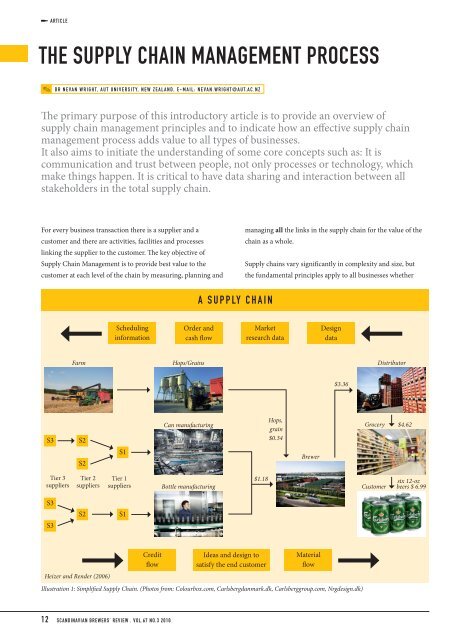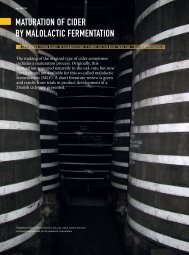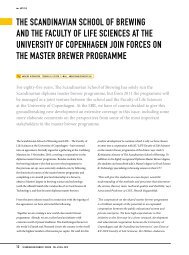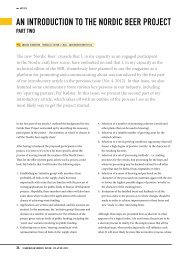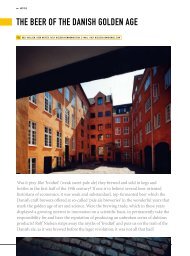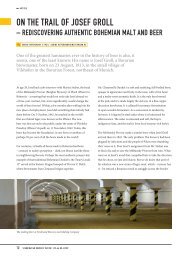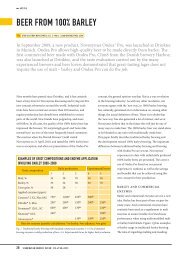the Supply chain ManageMent proceSS - Scandbrewrev.dk
the Supply chain ManageMent proceSS - Scandbrewrev.dk
the Supply chain ManageMent proceSS - Scandbrewrev.dk
You also want an ePaper? Increase the reach of your titles
YUMPU automatically turns print PDFs into web optimized ePapers that Google loves.
article<br />
The <strong>Supply</strong> Chain Management Process<br />
D r N e va n W r i g h t, A U T U n i v e r s i t y, N e w Z e a l a n d , e - m a i l : N e va n . w r i g h t @ a u t. a c . n z<br />
The primary purpose of this introductory article is to provide an overview of<br />
supply <strong>chain</strong> management principles and to indicate how an effective supply <strong>chain</strong><br />
management process adds value to all types of businesses.<br />
It also aims to initiate <strong>the</strong> understanding of some core concepts such as: It is<br />
communication and trust between people, not only processes or technology, which<br />
make things happen. It is critical to have data sharing and interaction between all<br />
stakeholders in <strong>the</strong> total supply <strong>chain</strong>.<br />
For every business transaction <strong>the</strong>re is a supplier and a<br />
customer and <strong>the</strong>re are activities, facilities and processes<br />
linking <strong>the</strong> supplier to <strong>the</strong> customer. The key objective of<br />
<strong>Supply</strong> Chain Management is to provide best value to <strong>the</strong><br />
customer at each level of <strong>the</strong> <strong>chain</strong> by measuring, planning and<br />
managing all <strong>the</strong> links in <strong>the</strong> supply <strong>chain</strong> for <strong>the</strong> value of <strong>the</strong><br />
<strong>chain</strong> as a whole.<br />
<strong>Supply</strong> <strong>chain</strong>s vary significantly in complexity and size, but<br />
<strong>the</strong> fundamental principles apply to all businesses whe<strong>the</strong>r<br />
A s u p p ly c h a i n<br />
Scheduling<br />
information<br />
Order and<br />
cash flow<br />
Market<br />
research data<br />
Design<br />
data<br />
Farm Hops/Grains Distributor<br />
$3.36<br />
S3<br />
S2<br />
S2<br />
S1<br />
Can manufacturing<br />
Hops,<br />
grain<br />
$0.34<br />
Brewer<br />
Grocery $4.62<br />
Tier 3<br />
suppliers<br />
Tier 2<br />
suppliers<br />
Tier 1<br />
suppliers<br />
Bottle manufacturing<br />
$1.18<br />
six 12-oz<br />
Customer beers $ 6.99<br />
S3<br />
S3<br />
S2<br />
S1<br />
Heizer and Render (2006)<br />
Credit<br />
flow<br />
Ideas and design to<br />
satisfy <strong>the</strong> end customer<br />
Material<br />
flow<br />
Illustration 1: Simplified <strong>Supply</strong> Chain. (Photos from: Colourbox.com, Carlsbergdanmark.<strong>dk</strong>, Carlsberggroup.com, Nrgdesign.<strong>dk</strong>)<br />
12 SCANDINAVIAN BREWERS’ REVIEW . VOL.67 NO.3 2010
The <strong>Supply</strong> Chain Management Process<br />
We see <strong>the</strong> supply <strong>chain</strong> not as a series of separate operations<br />
and organisations but as a complete end-to-end process of<br />
harvesting, manufacturing, warehousing, transporting, delivering<br />
and ultimate consumption.<br />
large or small. <strong>Supply</strong> Chain Management is not just for large<br />
organisations such as IBM, Wal-Mart, and Toyota.<br />
In a typical supply <strong>chain</strong>, raw materials are procured and items<br />
are produced at one or more factories, shipped to warehouses<br />
for intermediate storage and <strong>the</strong>n shipped to retailers or<br />
customers. Each member of a supply <strong>chain</strong> will have a different<br />
understanding of what a supply <strong>chain</strong> is reflecting in <strong>the</strong> nature<br />
of <strong>the</strong>ir business and <strong>the</strong> inputs and outputs produced. For<br />
some, supply <strong>chain</strong> is related to purchasing and procurement, to<br />
o<strong>the</strong>rs it is warehousing, distribution and transportation. Yet for<br />
o<strong>the</strong>rs, <strong>the</strong> emphasis will be on sources of capital and labour.<br />
Our definition includes all value-added activities required<br />
to plan, source, make and deliver products and services that<br />
ultimately meet customer needs. This includes <strong>the</strong> flow and<br />
exchange of information and <strong>the</strong> flow of money. <strong>Supply</strong> Chain<br />
Management is a process aimed to optimise integration of<br />
suppliers, manufacturers, warehouses and distribution, so that<br />
product is manufactured and delivers at <strong>the</strong> right quantities, to<br />
<strong>the</strong> right locations, and at <strong>the</strong> right time, to reduce costs over<br />
<strong>the</strong> whole <strong>chain</strong> to satisfy customer requirements. The objective<br />
is to optimise <strong>the</strong> <strong>chain</strong> as a whole and not just one component<br />
of <strong>the</strong> <strong>chain</strong> and it is more than just <strong>the</strong> flow of materials.<br />
<strong>Supply</strong> Chain Management considers demand, supply and<br />
inventory needs for each item of production and in particular<br />
looks at how inventory flows through <strong>the</strong> system to achieve<br />
output to <strong>the</strong> customer’s specification, in <strong>the</strong> right quantities,<br />
on time and at least cost to <strong>the</strong> <strong>chain</strong> as a whole. With <strong>Supply</strong><br />
Chain Management, customer service is increased through <strong>the</strong><br />
reduction of lead times and <strong>the</strong> product is always exactly as<br />
specified and it is always delivered on time. This is <strong>the</strong> delivery<br />
of a ‘perfect order’. Costs are reduced through <strong>the</strong> elimination<br />
of any activity that doesn’t add value and through <strong>the</strong> reduction<br />
of inventories of material and associated holding and handling<br />
costs throughout <strong>the</strong> <strong>chain</strong>.<br />
We see <strong>the</strong> supply <strong>chain</strong> not as a series of separate operations and<br />
organisations but as a complete end-to-end process of harvesting,<br />
manufacturing, warehousing, transporting, delivering and<br />
ultimate consumption. A simplified supply <strong>chain</strong> taken from an<br />
American textbook is illustrated on <strong>the</strong> left-hand page.<br />
Illustration 1 shows <strong>the</strong> up-stream flow of information, cash,<br />
and data and <strong>the</strong> downstream flow of credit, ideas and design,<br />
and <strong>the</strong> flow of materials to <strong>the</strong> end customer.<br />
Activities and measures based on customer requirements<br />
are very important in improving business performance. But<br />
Table 1:<br />
Performance R e s o u r c e e f f i c i e n c y ( V O B ) V o i c e o f C u s t o m e r ( V O C )<br />
Gap Matrix<br />
Machines<br />
1st<br />
Suppliers<br />
2nd<br />
Labour<br />
3rd<br />
Specification<br />
1st<br />
Price<br />
3rd<br />
Time<br />
2nd<br />
P E R F O R M A N C E OK 70% 80% 80% OK 60%<br />
SCANDINAVIAN BREWERS’ REVIEW . VOL.67 NO.3 2010 13
<strong>the</strong> <strong>Supply</strong> <strong>chain</strong> <strong>ManageMent</strong> <strong>proceSS</strong><br />
externally driven customer-based measures have to be matched<br />
by measures of what <strong>the</strong> company can do (feasibility, capacity,<br />
know-how and resources) to consistently meet customer<br />
expectations. A high standard of customer performance<br />
derives from planning, processes and actions integrated across<br />
<strong>the</strong> whole organisation. Externally, <strong>the</strong> measures include<br />
<strong>the</strong> suppliers at one end and <strong>the</strong> customer at <strong>the</strong> o<strong>the</strong>r end<br />
of <strong>the</strong> supply process. These externals, <strong>the</strong> supplier and <strong>the</strong><br />
customer, are matched with <strong>the</strong> internal requirements of <strong>the</strong><br />
manufacturing process.<br />
In any business or operation, a manager has to find a balance<br />
between two conflicting objectives of demand from customer<br />
and supply from operations, <strong>the</strong> ‘voice of <strong>the</strong> customer’ (VOC)<br />
and <strong>the</strong> ‘voice of business’ (VOB). Although customer service<br />
is <strong>the</strong> primary objective of <strong>Supply</strong> Chain Management, <strong>the</strong> level<br />
provided has to be sustainable and affordable to <strong>the</strong> business.<br />
Thus, <strong>the</strong> secondary objective of <strong>Supply</strong> Chain Management<br />
is to reduce costs and to be efficient in <strong>the</strong> use of resources.<br />
For simplicity, <strong>the</strong> three basic parameters of customer service<br />
are Specification, Price and Timing. The customer expects<br />
<strong>the</strong> goods or service to be delivered according to acceptable<br />
standards, to be of an affordable price and that <strong>the</strong>y arrive on<br />
time. The relative importance of Specification, Price and Time<br />
could change depending on market conditions, competition<br />
and demand. Given infinite resources, any business can provide<br />
adequate customer service, but many companies have gone out<br />
of business in spite of possessing satisfied customers, Wright<br />
and Race (2004). To provide a sustained and sustainable level<br />
of customer service, efficient use of resource is essential. When<br />
we study <strong>the</strong> objectives of VOC and VOB, <strong>the</strong>y have one thing<br />
in common, and that is Cost and Price. If we can reduce <strong>the</strong><br />
cost of production of goods or services by improved resource<br />
utilisation, <strong>the</strong>n we are in a better position to reduce <strong>the</strong> price<br />
and/or to improve <strong>the</strong> service at no extra cost to ourselves and/<br />
or to increase our margin of profit.<br />
Table 1 on <strong>the</strong> previous page is derived from work for a<br />
medium-sized New Zealand company. The relative importance<br />
of <strong>the</strong> key parameters for VOB were resource efficiency (i.e.<br />
Machines, Supplies and Labour) and VOC (i.e. Specification,<br />
Price and Time). It was found that <strong>the</strong> customers’ first priority<br />
S u p p ly c h a i n M a n a g e M e n t<br />
M a n u fa c t u r i n g<br />
t e c h n o l o g y<br />
S u p p l i e S<br />
M at e r i a l S<br />
p r o D u c t i o n D i S t r i B u t i o n<br />
S t o r a g e<br />
S u p p l i e r<br />
M at e r i a l S f l o W<br />
i n f o r M at i o n f l o W<br />
c u S t o M e r<br />
S u p p ly<br />
p l a n n i n g<br />
p r o D u c t i o n<br />
S c h e D u l i n g<br />
r e Q u i r e M e n t S<br />
p l a n n i n g<br />
S a l e S<br />
e S t i M at e S<br />
i n f o r M at i o n<br />
t e c h n o l o g y<br />
Illustration 2: Linear supply <strong>chain</strong><br />
14 SCANDINAVIAN BREWERS’ REVIEW . VOL.67 NO.3 2010
The <strong>Supply</strong> Chain Management Process<br />
was that our product met <strong>the</strong>ir specification. Although on-time<br />
delivery was important, it was no use if <strong>the</strong> product arrived<br />
on time but was below <strong>the</strong> required standard. In our example,<br />
<strong>the</strong> customer gave a performance ‘score’ of 80% for meeting<br />
specification (quality) and 60% for time (late deliveries). Price<br />
was OK. Having established <strong>the</strong> customers’ perception of <strong>the</strong><br />
service provided, <strong>the</strong> next step was to determine why <strong>the</strong> rating<br />
was below 100% for Specification and on Time delivery. In<br />
<strong>the</strong> consequential analysis of <strong>the</strong> three key resource inputs, it<br />
was found that machines and equipment were first class (latest<br />
technology, well maintained with no unplanned down time), <strong>the</strong><br />
people had <strong>the</strong> requisite skills, were reliable, <strong>the</strong> error rate is low,<br />
but <strong>the</strong>re was some idle time (productivity could be better). It<br />
was thought that improvements to people efficiency with more<br />
training could be achieved. However, <strong>the</strong> major constraint was<br />
that our suppliers were not sufficiently reliable (late deliveries<br />
and materials not always up to our quality standards). Action<br />
was taken to improve communication with key suppliers as to<br />
what was required. Gap analysis does not provide solutions to<br />
<strong>the</strong> conflicts, but identifies broad areas for attention.<br />
It is also important to note that <strong>the</strong> relative priorities of VOB<br />
and VOC can vary within <strong>the</strong> same business depending on<br />
<strong>the</strong> product and customer. To find solutions, <strong>the</strong> <strong>Supply</strong> Chain<br />
Manager will seek o<strong>the</strong>r tools, techniques and processes of<br />
<strong>Supply</strong> Chain Management such as Enterprise Resource<br />
Planning (ERP), which we will explain in later papers.<br />
The old approach to manufacturing was to buy from preferred<br />
suppliers and to negotiate terms and conditions to maximise<br />
your individual position and profit. Heavy reliance was placed<br />
on legal contracts and, if a large consumer, using purchasing<br />
power to gain favourable terms. Internally, <strong>Supply</strong> Chain<br />
Management would be considered to be <strong>the</strong> combining of<br />
functions of <strong>the</strong> business to plan, source, make and deliver<br />
products and services that meet customer needs as efficiently<br />
and as profitably as possible. In dealing with suppliers and<br />
immediate customers, <strong>the</strong> aim would be to get as good a deal<br />
as possible in buying from suppliers, and to get <strong>the</strong> best price<br />
from <strong>the</strong> customers and to maximise our profit. The belief being<br />
that for every winner <strong>the</strong>re has to be a loser, and <strong>the</strong> best way to<br />
maximise your position is to be <strong>the</strong> winner.<br />
Our approach for <strong>Supply</strong> Chain Management is to maximise<br />
<strong>the</strong> value for <strong>the</strong> complete <strong>chain</strong>. This is achieved through<br />
unreserved sharing of information and benefits. To do this, some<br />
long held beliefs, such as <strong>the</strong> concept of not sharing information<br />
for commercially sensitive reasons, have to be overcome. In<br />
reality, very little can truly be kept secret in today’s global<br />
environment. Any new advance in manufacture and technology<br />
will soon become common knowledge, copied and invariably be<br />
improved upon by <strong>the</strong> competition. Sharing of information and<br />
trust, not reliance on contacts, is <strong>the</strong> corner stone of true <strong>Supply</strong><br />
Chain Management.<br />
The individual components of <strong>Supply</strong> Chain Management are<br />
not new; we all have been managing parts of <strong>the</strong> supply <strong>chain</strong><br />
for years (e.g. buying, planning, scheduling, stock control,<br />
warehousing, logistics, distribution, etc.) without fully realising<br />
<strong>the</strong> significance of <strong>the</strong> whole <strong>chain</strong> concept. Likewise, <strong>the</strong> cost<br />
of <strong>the</strong> various elements of supply and distribution has been long<br />
recognised, over 90 years ago, for example, Ralph Barsodi (1929)<br />
wrote, ‘between 1870 and 1920 <strong>the</strong> cost of distributing necessities<br />
and luxuries has nearly trebled, while production costs have gone<br />
down by one fifth – what we are saving in production we are<br />
losing in distribution’.<br />
As indicated in illustration 2 on page 14, <strong>the</strong> traditional<br />
supply <strong>chain</strong> was concerned with a linear flow of information<br />
and products/services from customers to suppliers through<br />
various stages of processes while <strong>the</strong> information flow was <strong>the</strong><br />
domain of <strong>the</strong> commercial division and <strong>the</strong> conversion process<br />
of materials flow was a manufacturing or technical division<br />
responsibility. During <strong>the</strong> 1990s, <strong>the</strong> concept of total <strong>Supply</strong><br />
Chain Management shifted <strong>the</strong> responsibility for all elements of<br />
supply <strong>chain</strong> from cross functional control by one function ei<strong>the</strong>r<br />
Operations Management or to <strong>Supply</strong> Chain Management.<br />
The ‘old’ approach was that one department or function would<br />
be responsible for purchasing goods and services, ano<strong>the</strong>r for<br />
planning. Scheduling of activities was often a separate function,<br />
as was warehousing and distribution, and operations were just<br />
one step in <strong>the</strong> whole process of providing services. With <strong>the</strong><br />
value stream approach, functional boundaries are ignored and<br />
in many organisations it is now accepted that <strong>the</strong> operations<br />
16 SCANDINAVIAN BREWERS’ REVIEW . VOL.67 NO.3 2010
<strong>the</strong> <strong>Supply</strong> <strong>chain</strong> <strong>ManageMent</strong> <strong>proceSS</strong><br />
manager has to control <strong>the</strong> total process from purchasing input<br />
goods and services to <strong>the</strong> final stage of satisfying <strong>the</strong> customer.<br />
Marketing, accounting, human resources and o<strong>the</strong>r support<br />
functions do not show up on <strong>the</strong> value stream as such, but<br />
operations managers must be vitally interested and involved in<br />
<strong>the</strong>se internal functions of <strong>the</strong> organisation.<br />
The success of a supply <strong>chain</strong> is underpinned by <strong>the</strong> interaction<br />
between three key groups of players, viz. customers, external<br />
suppliers and <strong>the</strong> departments involved with <strong>the</strong> primary and<br />
secondary activities of <strong>the</strong> organisation.<br />
The customer is <strong>the</strong> central focus for any organisation. Marketing<br />
is too important to be left to <strong>the</strong> marketing department.<br />
Everyone in an organisation should be vitally interested in<br />
marketing <strong>the</strong> organisation. None<strong>the</strong>less, it is <strong>the</strong> function of <strong>the</strong><br />
marketing department to determine what <strong>the</strong> customer wants<br />
and what <strong>the</strong> competition is doing or is likely to do. Marketing<br />
specifies <strong>the</strong> product and its attributes. Attributes may range<br />
from <strong>the</strong> essential down to <strong>the</strong> desirable and perhaps include<br />
extras that <strong>the</strong> customer does not need. As well as defining <strong>the</strong><br />
product or service to be offered, marketing has to establish<br />
<strong>the</strong> price, forecast demand, have a say in how <strong>the</strong> product or<br />
service will be distributed or delivered, and, finally, marketing is<br />
responsible for promotion with <strong>the</strong> aim of stimulating demand.<br />
Marketing also has to sell <strong>the</strong> product/service internally within<br />
<strong>the</strong> organisation to <strong>the</strong> operations and o<strong>the</strong>r functions of<br />
<strong>the</strong> organisation. Marketing is <strong>the</strong> link with <strong>the</strong> market and<br />
customers and operations.<br />
some cases, <strong>the</strong> supplier can become involved in <strong>the</strong><br />
day-to-day operations of <strong>the</strong> organisation and might also be<br />
expected to advise and to assist in product development. Cost no<br />
longer becomes <strong>the</strong> key issue. Instead of price alone, suppliers<br />
will be judged on <strong>the</strong>ir loyalty and ability to deliver goods<br />
and services to <strong>the</strong> required standard and on time. Suppliers<br />
can also become part of <strong>the</strong> information-ga<strong>the</strong>ring arm of <strong>the</strong><br />
organisation; often, suppliers have a different perspective as to<br />
what <strong>the</strong> competition are up to (changes in buying patterns,<br />
timetables, new packaging, use of new materials and so on).<br />
Suppliers are also in a good position to offer technical advice<br />
regarding new technology and alternative materials.<br />
Communication between departments (especially marketing,<br />
operations and logistics) within an organisation has to be<br />
two-way and has to be aimed to help ra<strong>the</strong>r than as a means of<br />
apportioning blame or criticising. The same approach applies with<br />
key suppliers. With traditional hierarchical organisations, a bunker<br />
mentality can develop whereby each function is walled off from<br />
<strong>the</strong> o<strong>the</strong>r, and any suggestion, no matter how helpful, is taken as<br />
a threat or a challenge. World-class organisations are noted by <strong>the</strong><br />
manner in which <strong>the</strong> figurative brick walls that separate functions<br />
have been broken down, and by <strong>the</strong> teamwork that exists between<br />
all functions to achieve <strong>the</strong> common goal. This requires that<br />
everyone in <strong>the</strong> organisation knows what <strong>the</strong> goals and objectives<br />
are and that <strong>the</strong> culture is conducive to <strong>the</strong> enthusiastic pursuit of<br />
<strong>the</strong> goals for <strong>the</strong> common good of <strong>the</strong> whole, ra<strong>the</strong>r than for <strong>the</strong><br />
specific interests of one department. Information is open to all and<br />
to key suppliers, and <strong>the</strong>re are no secrets.<br />
In some organisations, suppliers are treated with distrust and<br />
<strong>the</strong> business strategy adopted is to shop around and to get <strong>the</strong><br />
best deal on each occasion. In <strong>the</strong>se types of organisations,<br />
information is not shared with suppliers. When orders are<br />
placed, <strong>the</strong> suppliers are not told what <strong>the</strong> purpose of <strong>the</strong> order<br />
is and, thus, are not in a position to advise, even if <strong>the</strong>y were so<br />
inclined, of alternative products or new technology. With this<br />
approach, little loyalty is shown to any supplier, and <strong>the</strong> supplier<br />
is almost treated as an adversary. The value stream approach is to<br />
treat key suppliers of goods and services as part of <strong>the</strong> team, and<br />
to share information and to seek advice. Key suppliers are those<br />
that are important to <strong>the</strong> smooth operation of <strong>the</strong> system. In<br />
r e f e r e n c e S :<br />
Barsodi, R (1929). The Distribution Age. New York: Appleton<br />
Basu, R.N and Wright J.N (2008). Total <strong>Supply</strong> Chain<br />
Management. Oxford, UK: Butterworth and Heinemann<br />
Heizer, J and Render, B (2006). Operations Management.<br />
New York: Prentice Hall<br />
Wright, J.N and Race, P (2004). The Management of Service<br />
Operations. London, UK: Cenage Learning<br />
ScanDinavian BreWerS’ revieW . vol.67 no.3 2010 17


